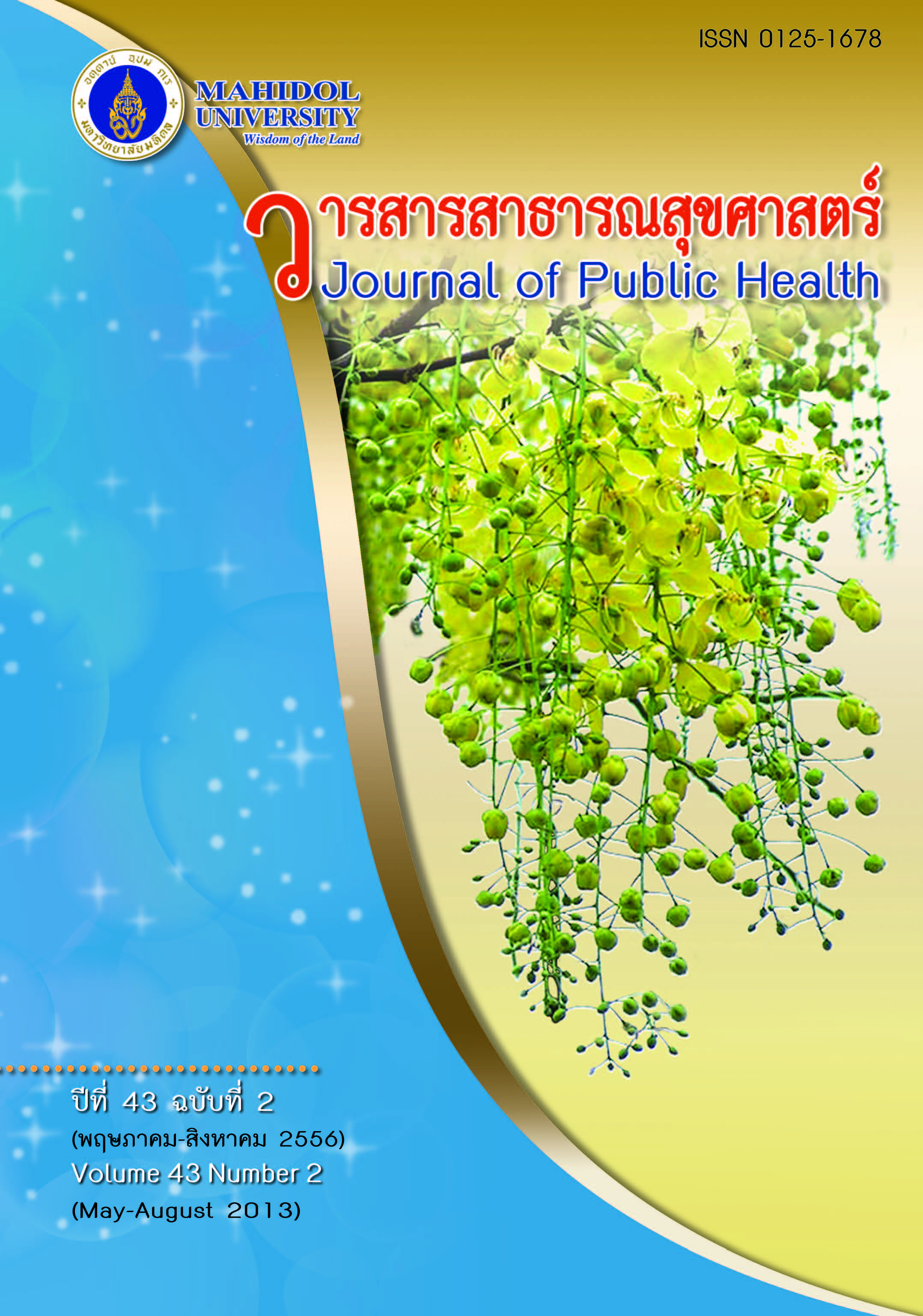ความชุกของการติดเชื้อปรสิตลำไส้ในกลุ่มอาสาสมัครสาธารณสุขประจำหมู่บ้าน เทศบาลตำบลป่าอ้อดอนชัย อำเภอเมืองเชียงราย จังหวัดเชียงราย
Keywords:
direct simple smear, formalin-ethyl acetate sedimentation, potassium permanganate staining, ปรสิตลำไส้, ความชุก, อาสาสมัครสาธารณสุขประจำหมู่บ้าน, intestinal parasite, prevalence, village health volunteerAbstract
บทคัดย่อ
การศึกษาครั้งนี้เป็นการวิจัยแบบตัดขวางเพื่อศึกษาอัตราความชุกของการติดเชื้อปรสิตลำไส้ในกลุ่มอาสาสมัครสาธารณสุขประจำหมู่บ้าน เขตเทศบาลตำบลป่าอ้อดอนชัย อำเภอเมืองเชียงราย จังหวัดเชียงราย ช่วงเดือนเมษายน-พฤษภาคม พ.ศ. 2555 ตัวอย่างอุจจาระที่ส่งตรวจทั้งหมดมีจำนวน 159 ตัวอย่าง ตรวจโดยใช้วิธี Direct simple smear, Formalin-ethyl acetate sedimentation และ Potassium permanganate staining ข้อมูลคุณลักษณะทั่วไปและพฤติกรรมสุขภาพที่เกี่ยวข้องกับการป้องกันและควบคุมโรคติดเชื้อปรสิตลำไส้ใช้แบบสอบถามในการเก็บรวบรวมข้อมูล ผลการศึกษาพบว่าอัตราความชุกของโรคติดเชื้อปรสิตลำไส้เท่ากับร้อยละ 30.2 ซึ่งประกอบด้วย อัตราการติดเชื้อหนอนพยาธิร้อยละ 27.7 ในขณะที่พบอัตราการติดเชื้อโปรโตซัวร้อยละ 2.5 เชื้อที่ตรวจพบมากที่สุดคือ พยาธิใบไม้ลำไส้ขนาดเล็ก (Minute Intestinal Fluke) ร้อยละ 13.8 และพยาธิสตรองจิลอยเดส (Strongyloides stercoralis) ร้อยละ13.8 รองลงมาคือ เอ็นโดไลแมก นานา (Endolimax nana) ร้อยละ 1.3 พยาธิปากขอ (Hookworm) ร้อยละ 0.6 พยาธิไส้เดือน (Ascaris lumbricoides) ร้อยละ 0.6 พยาธิใบไม้ลำไส้ขนาดใหญ่ (Fasciolopsis buski) ร้อยละ 0.6 เอ็นตามีบา ฮิสโตไลติก้า/ดิสพา (Entamoeba histolytica/dispar) ร้อยละ 0.6 และเอ็นตามีบา โคไล (Entamoeba coli) ร้อยละ 0.6 จากการศึกษาครั้งนี้พบว่า การติดเชื้อปรสิตลำไส้ยังคงเป็นปัญหาสาธารณสุขที่สำคัญในจังหวัดเชียงราย ดังนั้นการดำเนินการให้สุขศึกษาและการปรับเปลี่ยนพฤติกรรมนั้นเป็นปัจจัยสำคัญที่ทำให้ประสบผลสำเร็จในการควบคุมและป้องกันโรคติดเชื้อปรสิตภายในชุมชนได้
Prevalence of Intestinal Parasitic Infections among Village Health Volunteers in Paordonchai Tambon Municipality, Mueang Chiang Rai District, Chiang Rai Province
ABSTRACT
A cross-sectional study was conducted to determine the prevalence rate of intestinal parasitic infections among village health volunteers in Paordonchai tambon municipality, Mueang Chiang Rai district, Chiang Rai province during April to May 2012. A total of 159 stool samples were examined using direct simple smear technique, formalin-ethyl acetate sedimentation technique and potassium permanganate staining method. Data on demographic and health behavior bearing on the prevention and control of intestinal parasitic infections were collected using questionnaires. The results showed that the prevalence rate of intestinal parasitic infections was 30.2%, including a rate of 27.7% helminthic infections and 2.5% protozoan infections. The most common parasites detected were minute intestinal flukes, 13.8%, and Strongyloides stercoralis, 13.8%, followed by Endolimax nana 1.3%, hookworm 0.6%, Ascaris lumbricoides 0.6%, Fasciolopsis buski 0.6%, Entamoeba histolytica/dispar 0.6% and Entamoeba coli 0.62%. This study revealed that intestinal parasitic infection is still an important public health problem in Chiang Rai Province. Therefore, the implementation of health education and behavioral changes remain critical factors in the success of prevention and control measures for intestinal parasitic infections in communities.
Downloads
Issue
Section
License
Creative Commons License CC-BY-ND


